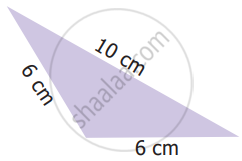Advertisements
Advertisements
प्रश्न
O is any point in the interior of ΔABC. Prove that
(i) AB + AC > OB + OC
(ii) AB + BC + CA > OA + QB + OC
(iii) OA + OB + OC >` 1/2`(AB + BC + CA)
उत्तर
Given that O is any point in the interior of ABC
We have to prove
(i) AB + AC > OB + OC
(ii) AB + BC + CA > OA + QB + OC
(iii) OA + OB + OC >`1/2`(AB + BC + CA)
We know that, in a triangle the sum of any two sides is greater than the third side So, we have
In ΔABC
AB+BC>AC
BC+AC>AB
AC+AB>BC
In ΔOBC
OB+OC>BC ...........(1)
In ΔOAC
OA+OC>AC ...........(2)
In ΔOAB
OA+OB>AB ............(3)
Now, extend (or) produce BO to meet AC in D.
Now, in ΔABD,we have
AB+AD+BD
⇒ AB+AD>BO+OD .............(4) [∵ BD=BO+OD]
Similarly in , ΔODC we have
OD+DC>OC ...............(5)
(1) Adding (4) and (5), we get
AB+AD+OD+DC>BO+OD+OC
⇒AB+(AD+DC)>OB+OC
⇒ AB+AC>OB+OC ...............(6)
Similarly, we have
BC+BA>OA+OC ...............(7)
and CA+CB>OA+OB ..............(8)
(2) Adding equation (6), (7) and (8), we get
AB+AC+BC+BA+CA+CB>OB+OC+OA+OC+OA+OB
⇒2AB+2BC+CA>2OA+2OB+2OC
⇒2(AB+BC+CA>OA+OB+OC)
⇒AB+BC+CA>OA+OB+OC
(3) Adding equations (1), (2) and (3)
OB+OC+OA+OC+OA+OB+>BC+AC+AB
⇒2OA+2OB+2OC>AB+BC+CA
We get⇒ 2(OA+OB+OC)>AB+BC+CA
∴ (OA+OB+OC)>`1/2`(AB+BC+CA)
APPEARS IN
संबंधित प्रश्न
Angles A, B, C of a triangle ABC are equal to each other. Prove that ΔABC is equilateral.
Which of the following statements are true (T) and which are false (F):
Angles opposite to equal sides of a triangle are equal
Which of the following statements are true (T) and which are false (F):
The measure of each angle of an equilateral triangle is 60°
Which of the following statements are true (T) and which are false (F) :
If the altitude from one vertex of a triangle bisects the opposite side, then the triangle may be isosceles.
Which of the following statements are true (T) and which are false (F):
If the bisector of the vertical angle of a triangle bisects the base, then the triangle may be isosceles.
In the given figure, the sides BC, CA and AB of a Δ ABC have been produced to D, E and F respectively. If ∠ACD = 105° and ∠EAF = 45°, find all the angles of the Δ ABC.
Which of the following correctly describes the given triangle?
In ∆PQR, if ∠R > ∠Q, then ______.
In triangles ABC and PQR, AB = AC, ∠C = ∠P and ∠B = ∠Q. The two triangles are ______.
Show that in a quadrilateral ABCD, AB + BC + CD + DA < 2(BD + AC)
